Oh, it's so exciting. Carmela Biscuit knitted this hat from my pattern. I love seeing variations on a theme. This color is beautiful.
Sunday, December 26, 2010
Tuesday, October 19, 2010
"Wrong Side" of ribbed entrelac hat 10 squares
Thanks in part to a certain Russian chat website, this knitting picture has joined the "1,000 views" club on Flickr!
Tuesday, September 14, 2010
Larger "Dayflower" knitting stitch pattern chart
The original 'Dayflower' knitting stitch pattern, from Barbara Walker's Second Treasury of Knitting Patterns, is very pretty, but published only as written instructions.
I figured out how to chart it, and from that chart I have now derived a slightly larger version of the stitch pattern. I'm knitting it up now (2010-09-14) to see how it will come out.
I figured out how to chart it, and from that chart I have now derived a slightly larger version of the stitch pattern. I'm knitting it up now (2010-09-14) to see how it will come out.
Thursday, June 24, 2010
Mind Hacks: Against narrativity
that special, fabulously misplaced confidence that people feel when, considering elements of their own experience that are existentially fundamental for them, they take it that they must also be fundamental for everyone else.
via mindhacks.com
Tuesday, March 30, 2010
Perfecting the perpendicular pickup -- just the video, ma'am
-
Anyway, I downloaded edited that file and uploaded the real thing. I am all about the closed-captioning. I love me some deaf knitters, and knitters who don't speak English as a first language will probably have better luck understanding the captions than my slurry words.
Does anybody use an on-line service for this? I remember reading something about Google making it easier to caption their videos, but my Google-fu is not working for this.
via youtube.com
I uploaded my latest video to YouTube, and I requested that YouTube create a machine-transcribed caption file for it. Wow, pretty amusing. As in all machine transcriptions, it was pretty weird. Could have something to do with my mumbling, maybe.Anyway, I downloaded edited that file and uploaded the real thing. I am all about the closed-captioning. I love me some deaf knitters, and knitters who don't speak English as a first language will probably have better luck understanding the captions than my slurry words.
Does anybody use an on-line service for this? I remember reading something about Google making it easier to caption their videos, but my Google-fu is not working for this.
Perfecting the Perpendicular Pickup
In a previous post, I described how to join knitted pieces at right angles to each other, in such a way that the join is as neat as possible. The join used the sliding-loop technique devised by Rick Mondragon. In Mondragon's technique you are joining two pieces of knitting with parallel grain. With the perpendicular join, you join the side edge of the piece you are knitting to a row of free loops from another piece of knitting.
Picking up and knitting stitches from an existing piece of knitting involves two steps, inserting a needle and pulling through a loop. Where is a good place to insert the needle? Normally, you are told to insert the left needle one stitch in from the edge of the knitting. The reason for that is that the last column of stitches is ill-formed. At least, the edge half-column is. But reaching that far into the knitting creates a bulky join, and moves the ugly column to the wrong side of the knitting. That's OK when there is a public side and a private side, but what about entrelac scarves? Wouldn't it be nice to have a method of picking up stitches that doesn't leave your knitting with an ugly side?
In this post, I would like to describe my method of picking up and knitting stitches from a selvedge. In entrelac knitting, half of the connections between squares are made this way.
Picking up and knitting stitches from an existing piece of knitting involves two steps, inserting a needle and pulling through a loop. Where is a good place to insert the needle? Normally, you are told to insert the left needle one stitch in from the edge of the knitting. The reason for that is that the last column of stitches is ill-formed. At least, the edge half-column is. But reaching that far into the knitting creates a bulky join, and moves the ugly column to the wrong side of the knitting. That's OK when there is a public side and a private side, but what about entrelac scarves? Wouldn't it be nice to have a method of picking up stitches that doesn't leave your knitting with an ugly side?
There is. If you use the loops that are formed by the turning of the knitting as it goes back and forth, you get the neatest possible stitch pick up. However, finding that turning-loop is not easy.
If knitting existed in some Platonic realm, the edge of knitting would look like this, and one would simply slide the left needle along the selvedge and pick up loops to be worked as the first row of the new knitted piece.
Alas, there are physical forces at work in the real world that transform the ideal into the actual. Instead of easily-identified turning loops, one has a chain of knots joined by gappy loops:
Ah, but the turning loops are in there somewhere. You "merely" have to re-form that ugly half-stitch at the selvedge.
Here's a diagram that shows how the Platonic ideal of a selvedge stitch gets transformed into a knot-and-loopy mess:
So, all we have to do is use a needle to reverse the process. Here's a written description of the process... bu you can ignore all that except the diagram and skip to the video...
- Look at the knitting. Starting from the top edge of the knitting, there is a series of loops and knots alternating all the way down to the beginning. Orient the knitting so that the right side is facing you, the selvedge edge is parallel to the floor, and the knitting is hanging down from it. The top (last-knitted) edge of the knitting is on your right. The bottom (first-knitted) edge of the knitting is on your left.
- On the selvedge, the loops are being clutched by the knots. With your eyes, follow a loop's yarn down (towards the beginning edge of the knitting) through the knot to where it joins the back (purl side) of the knitting.
- Insert the tip of the left needle upward (parallel to the selvedge, from your left to your right, pointing toward the top edge) through the length of yarn between the knot and the rest of the knitting. You'll know you have the correct bit of yarn if you can see the gappy loop decreasing in size as you insert the needle more into the bit of yarn, since you're robbing yarn from the gappy loop to make the little bit of yarn bigger. This piece is the purplish piece of yarn in the diagram below:
- With the tip of the needle, scoop the rest of the gappy loop toward the back of the work, while letting the bit of yarn you just poked through fall off the needle, as follows. When you're starting the scoop, you're going to swing the point of the needle toward you and perpendicular to the plane of the knitting. To perform the scoop, you'll be swinging the tip of the needle through the plane of the fabric, pointing to the floor. At the end of the scoop, the needle is pointing away from you and perpendicular to the plane of the knitting.
- At the end of the motion, move the needle back to the position of step 3. You should have a loop on the needle in the standard mount position. Knit the loop off the left needle.
- Go back to step 2, using the next gappy loop down (toward the beginning of the knitting.)
It's video time:
Saturday, March 20, 2010
Perfecting the Perpendicular Join
The photos below show closeups of two entrelac joins done with the same needles and the same yarn by the same knitter (me).
The first photo shows one common way to join two pieces of knitting in entrelac. The beige piece was knitted first, and the green piece was joined, every two rows, by working a ssk, using the last stitch of a right-to-left green row and a free loop from held beige stitches. For a neater join, the first stitch of the return left-to-right row is slipped, with the yarn in back.
Notice that there is beige showing through the green stitches. This show-through, also called grinning, is pretty inevitable when you are forming a decrease (ssk) with two colors of yarn.
Notice also, the second column of green stitches (counting left-to-right) looks somewhat distorted. This is a consequence of the slipped stitches pulling at every other stitch in that column and making the left leg of that stitch smaller.
The next picture shows a neater join that I invented. Instead of working together the selvedge stitches of the green piece and held loops from the beige, I pulled a long green loop from each beige stitch and used the loop of yarn to work two rows of green, from left to right and then from right to left.
There is no show-through of the other color here. The first column of green stitches is slightly distorted. This is because the ratio of green rows to beige columns (stitches) is forced to be 2:1 instead of the more "natural" 3:2 or 4:3. This makes the green stitches look a little "squashed" since they "want" to be a little taller. It's not bad, though, and really, slipping stitches as in the first photo adds its own kind of distortion.
The second green stitch column looks a lot better, though. That's another benefit to this method.
Here's a rough diagram of the structure of the join:
Thursday, March 18, 2010
Norwegian purl method video
via vimeo.com
This video shows the wacky Norwegian Purl method. I like that for the video they used big yarn, big needles and good lighting. I'm going to try this and report back to you all.
The Knitting Laboratory: Barter for Garter
The list of people for whom I will knit for free looks suspiciously like the list of people for whom I would donate a kidney.
Good post that answers the perennial question "Will you knit me something?"
Tuesday, March 16, 2010
Ways to join knitted pieces
Joining a piece already knit to one you are knitting, in parallel or perpendicularly.
1 This is a new technique I developed, to be described in more detail later. Basically, on the existing piece, you ladder-down the edge stitch column, freeing a loop for every two rows of the existing piece. You then chain up these loops while working together with each loop a free stitch from the current piece.
2 To be described later.
3 See blog entry: "Picking up and knitting from a cast-on edge."
| Edge of existing piece | Edge of piece being knit | Ways to make the join | Diagram |
| Side | Side | Sliding-loop (Rick Mondragon), sewn seam. | |
| Side | Bottom | Picking up stitches from a selvedge. |
|
| Side | Top | Perpendicular grafting, sewn seam, chaining-up1 . |
|
| Top | Side | Entrelac join (ssk or p2tog), sliding loop (me)2 , sewn seam. |
|
| Top | Bottom | Knitting from held stitches, grafting. |
|
| Top | Top | Grafting, three-needle bind-off, sewn seam. |
|
| Bottom (some techniques require loops be freed from provisional cast-on) | Side | Entrelac join (ssk or p2tog), sliding-loop (me), sewn seam. |
|
| Bottom | Bottom | Knitting from freed cast-on loops, grafting, "aligned pickup from cast-on edge"3 . |
|
| Bottom | Top | Grafting, sewn seam. |
|
notes
1 This is a new technique I developed, to be described in more detail later. Basically, on the existing piece, you ladder-down the edge stitch column, freeing a loop for every two rows of the existing piece. You then chain up these loops while working together with each loop a free stitch from the current piece.
2 To be described later.
3 See blog entry: "Picking up and knitting from a cast-on edge."
Related articles by Zemanta
- Entrelac joins comparison swatch (fuzzyjay.blogspot.com)
- Entrelac diagrams (fuzzyjay.blogspot.com)
- TECHknitting (timesunion.com)
- Diagramming and Designing an entrelac piece (fuzzyjay.blogspot.com)
Sunday, March 14, 2010
Lace knitting charts from 17 and 18 years ago
 Cover of Charted Knitting Designs
Cover of Charted Knitting DesignsThe patterns are similar to the ones I designed and used in my wall-hanging called Lace Curlicues:
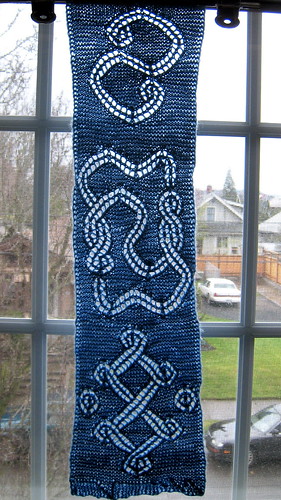
Go ahead and click on the "preview on posterous" icon below if you're interested:
Monday, March 08, 2010
Charting 'Dayflower'
Dayflower is a really pretty pattern in Barbara Walker's Second Treasury of Knitting Patterns, but it only has written directions. I was looking for a challenge for my charting skills and this one looked like a good one. It took me a while, but I figured it out. Here are some of the steps I used.
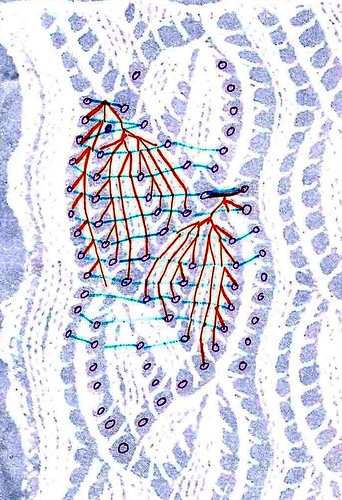
Charting 'Dayflower', originally uploaded by fuzzyjay.
Straightening out the lines that represent rows, with no regard to spacing of stitches:
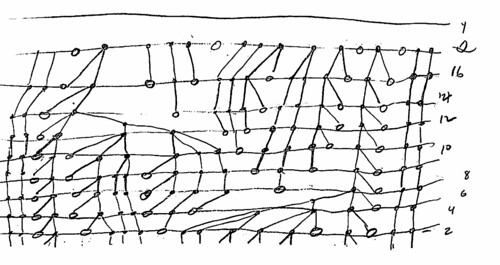
Eventually I got to this point where I could arrange the stitches on a chart. The trick there was to figure out, based on the photo and the previous attempt, how to move the rows back and forth for best alignment of the stitch columns.:

Once I had the stitch columns aligned properly vertically, I could do the more-detailed stitch diagram. This one shows the path of the yarn through all the stitches, but not the actual over-and-under crossings of the yarn as the stitches are made. It's a bit sketchy because I only did one half of a repeat, then used Photoshop to flip and copy the repeats, and my Photoshop skills are not the best:

As I've said before, I'd rather figure out 5 ways to diagram a knitting pattern than knit it. I'm all about understanding the architecture...
I am grateful that iLoveButter on Flickr has shared this photo under a Creative Commons license so I can show you the pattern used in a garment (before blocking, which will open up the lace):
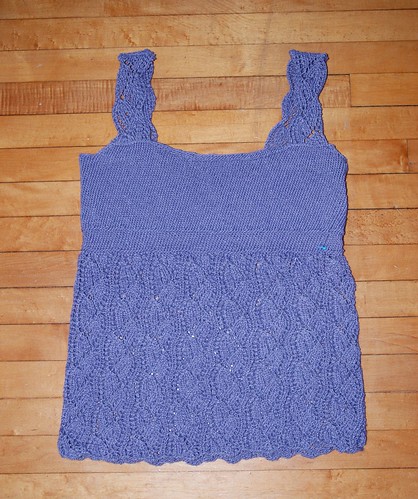
Related articles by Zemanta
- Dayflower Diagram, neatened (fuzzyjay.blogspot.com)
- Illustrating lace knitting (fuzzyjay.blogspot.com)
- Charting Marianne Kinzel's "Ladybird" pattern (fuzzyjay.blogspot.com)
Labels:
Barbara G. Walker,
craft,
knitting,
lace knitting,
Needlework
Tuesday, March 02, 2010
Cabled entrelac Greek Key
How to do a continuous, sinuous cable using entrelac squares. The cable travels across the diagonals of some of the squares.
Previous posts explain the meaning of the arrows and the numerals. The green lines represent the repeat of 18 entrelac squares (15 squares + 6 half-squares [triangles]).
Three repeats are shown. The left repeat has 16.5 squares (12 squares + 9 half-squares) and the right repeat has 19.5 squares (15 squares + 9 half-squares).
All three repeats add up to 3 × 18 squares or 54 squares (42 squares + 24 half-squares, which is why the numberals go up to 66).
Here are some pieces I've knit that include the continous-cable idea in entrelac. Click the picture to go to the Flickr page for the item:
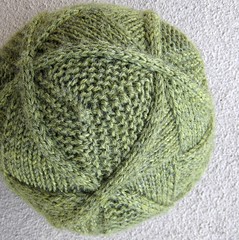
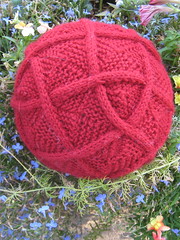

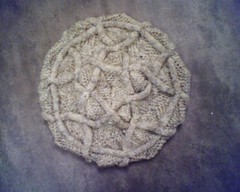
Previous posts explain the meaning of the arrows and the numerals. The green lines represent the repeat of 18 entrelac squares (15 squares + 6 half-squares [triangles]).
Three repeats are shown. The left repeat has 16.5 squares (12 squares + 9 half-squares) and the right repeat has 19.5 squares (15 squares + 9 half-squares).
All three repeats add up to 3 × 18 squares or 54 squares (42 squares + 24 half-squares, which is why the numberals go up to 66).
Here are some pieces I've knit that include the continous-cable idea in entrelac. Click the picture to go to the Flickr page for the item:




Related articles by Zemanta
- Diagramming and Designing an entrelac piece (fuzzyjay.blogspot.com)
- Continuous-loop cable design (fuzzyjay.blogspot.com)
- Entrelac diagrams (fuzzyjay.blogspot.com)
Sunday, February 28, 2010
Entrelac joins comparison swatch
These photos show a swatch with two different entrelac joins.
On the left of the swatch (the right when flipped over) is the usual method of slipping the first stitch in every row of each entrelac square. Stitches for new squares are picked up from behind the slipped stitches. The squares are joined along their selvedges by working a stitch together with a live stitch from a previous square (on the left selvedge by ssk and on the right selvedge by p2tog).
On the right is the new method I've developed (not entirely original). For the squares on the right, the first stitch in each row is worked. Stitches for new squares in this method are picked up from the thread between the last stitch of a row and the first stitch of the next row (the turning thread). Squares are joined not by decreasing but by pulling loops from live stitches of a previous square and using that loop to knit two rows of the new square.
One advantage of the new method is apparent in the close-up pictures. There is no "grinning"-through (an industrial-knitting term) of the other color along the selvedges of the entrelac square.
Another thing to note about this swatch: The new joining method produces slightly bigger squares, since there is less overlap between adjacent squares. That is, the squares are no bigger, but the fabric produced is slightly bigger because of less overlap.
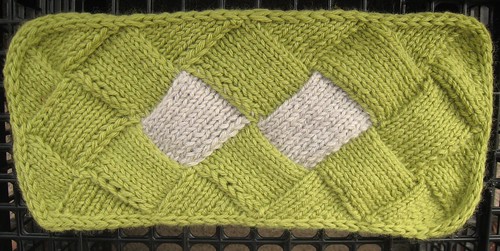


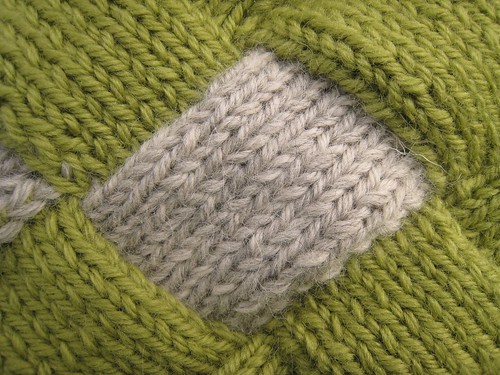
Below, I show the two sides of the swatch before blocking:
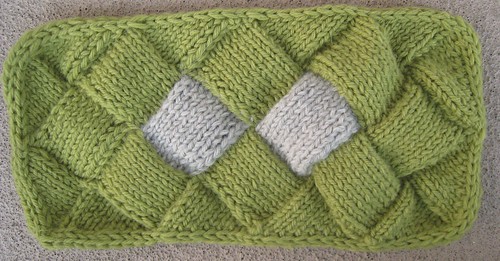

Notice how the new method produces entrelac fabric that has much higher relief. The fabric becomes much flatter with blocking.
I'm going to illustrate the two components of the new entrelac join (picking up from the turning thread, and the loop selvedge-join) in a later post.
On the left of the swatch (the right when flipped over) is the usual method of slipping the first stitch in every row of each entrelac square. Stitches for new squares are picked up from behind the slipped stitches. The squares are joined along their selvedges by working a stitch together with a live stitch from a previous square (on the left selvedge by ssk and on the right selvedge by p2tog).
On the right is the new method I've developed (not entirely original). For the squares on the right, the first stitch in each row is worked. Stitches for new squares in this method are picked up from the thread between the last stitch of a row and the first stitch of the next row (the turning thread). Squares are joined not by decreasing but by pulling loops from live stitches of a previous square and using that loop to knit two rows of the new square.
One advantage of the new method is apparent in the close-up pictures. There is no "grinning"-through (an industrial-knitting term) of the other color along the selvedges of the entrelac square.
Another thing to note about this swatch: The new joining method produces slightly bigger squares, since there is less overlap between adjacent squares. That is, the squares are no bigger, but the fabric produced is slightly bigger because of less overlap.




Below, I show the two sides of the swatch before blocking:


Notice how the new method produces entrelac fabric that has much higher relief. The fabric becomes much flatter with blocking.
I'm going to illustrate the two components of the new entrelac join (picking up from the turning thread, and the loop selvedge-join) in a later post.
Friday, February 26, 2010
Four entrelac hats
These are the last four hats that I designed and knit. They are meant to be worn with the brim folded up, either inside or outside, for more ear-warmness. To that end, the fabric is reversible. The red patch on the first hat looks better on the other side, since the red-green join is less speckled on that side.
Thursday, February 18, 2010
YAREH! Yet another ribbed-entrelac hat
Lori made herself a ribbed entrelac hat using the techniques I taught her. It's her own design, though it shares an affinity with the other hats I made with this technique. Like the others, it's seamless, reversible and knit in one piece. I guess seamless implies one-piece... well, maybe not, since Elizabeth Zimmerman's sweater designs are often seamless but not made in one piece. Here she is, modeling it at Knit Purl's Thursday night Sip 'n' Stitch:
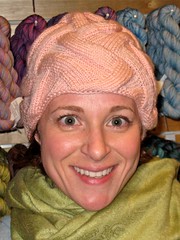
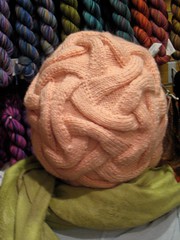
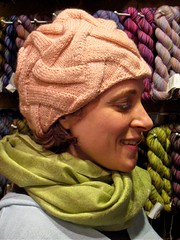
I am such a proud "uncle"! Now Lori says she'll write up a pattern for this that I can edit. I hope we can then teach a class at a local yarn store.



I am such a proud "uncle"! Now Lori says she'll write up a pattern for this that I can edit. I hope we can then teach a class at a local yarn store.
Subscribe to:
Comments (Atom)
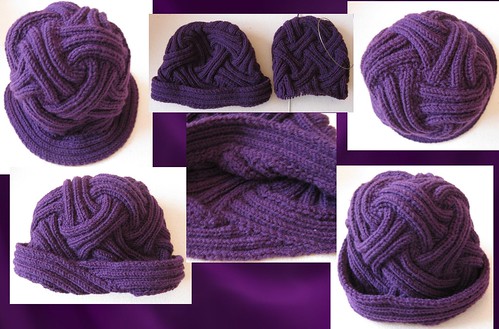
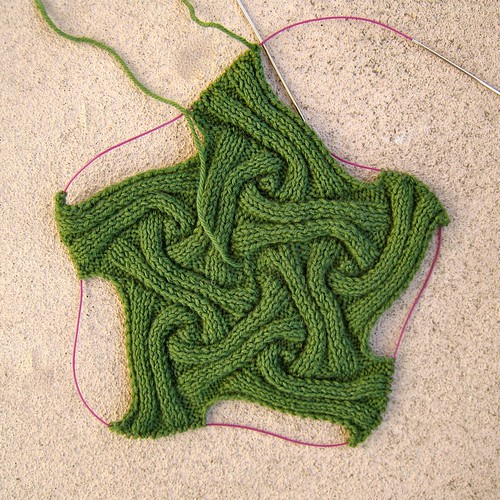
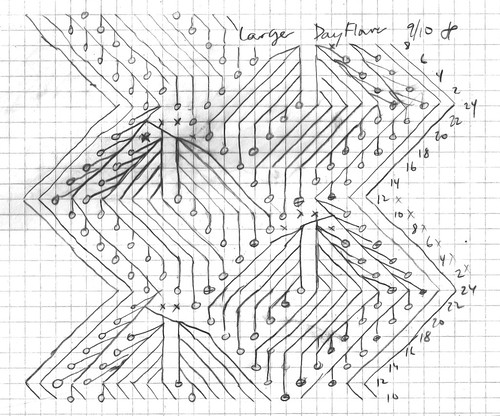

![Reblog this post [with Zemanta]](http://img.zemanta.com/reblog_e.png?x-id=efdcc997-5db2-49dd-bd50-55c3fdc8927d)









![Reblog this post [with Zemanta]](http://img.zemanta.com/reblog_e.png?x-id=4cec9ce2-6659-4f35-859c-d232cc6dc270)

![Reblog this post [with Zemanta]](http://img.zemanta.com/reblog_e.png?x-id=d6643244-46be-4a29-a24e-da2ef2c7e453)
![Reblog this post [with Zemanta]](http://img.zemanta.com/reblog_e.png?x-id=e0e01f8a-247b-4c78-847f-46d675a3e184)
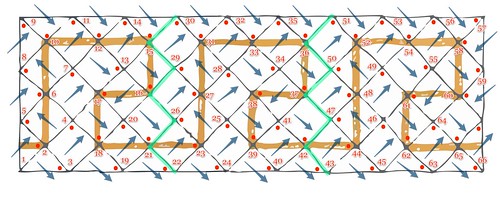
![Reblog this post [with Zemanta]](http://img.zemanta.com/reblog_e.png?x-id=09ee3e97-b26f-48c1-8d7d-d3e440413483)
![Reblog this post [with Zemanta]](http://img.zemanta.com/reblog_e.png?x-id=d9be8abc-1843-4b9b-87c9-a944e4317e57)

![Reblog this post [with Zemanta]](http://img.zemanta.com/reblog_e.png?x-id=b2d1fad2-2bf9-4f04-889f-9d0cada97933)